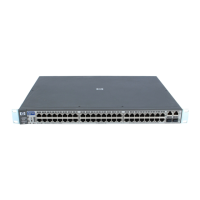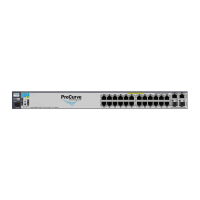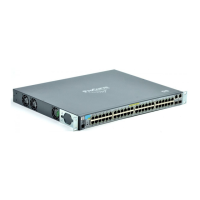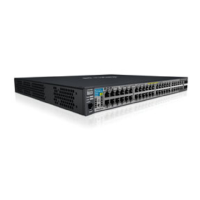7-3
Configuring IP Addressing
IP Configuration
IP Configuration
IP Configuration Features
IP Address and Subnet Mask. Configuring the switch with an IP address
expands your ability to manage the switch and use its features. By default, the
switch is configured to automatically receive IP addressing on the default
VLAN from a DHCP/Bootp server that has been configured correctly with
information to support the switch. (Refer to “DHCP/Bootp Operation” on page
7-10 for information on setting up automatic configuration from a server.)
However, if you are not using a DHCP/Bootp server to configure IP addressing,
use the menu interface or the CLI to manually configure the initial IP values.
After you have network access to a device, you can use the web browser
interface to modify the initial IP configuration if needed.
For information on how IP addressing affects switch performance, refer to
“How IP Addressing Affects Switch Operation” on page 7-9.
Default Gateway Operation. The default gateway is required when a
router is needed for tasks such as reaching off-subnet destinations or forward-
ing traffic across multiple VLANs. The gateway value is the IP address of the
next-hop gateway node for the switch, which is used if the requested destina-
tion address is not on a local subnet/VLAN. If the switch does not have a
manually-configured default gateway and DHCP/Bootp is configured on the
primary VLAN, then the default gateway value provided by the DHCP or Bootp
server will be used. If the switch has a manually configured default gateway,
then the switch uses this gateway, even if a different gateway is received via
DHCP or Bootp on the primary VLAN. (This is also true for TimeP and a non-
default Time-To-Live.) See “Notes” on page 7-4 and “The Primary VLAN” on
page 11-7.
Packet Time-To-Live (TTL) . This parameter specifies how long in sec-
onds an outgoing packet should exist in the network. In most cases, the default
setting (64 seconds) is adequate.
Feature Default Menu CLI Web
IP Address and Subnet Mask DHCP/Bootp page 7-5 page 7-7 page 7-9
Default Gateway Address none page 7-5 page 7-7 page 7-9
Packet Time-To-Live (TTL) 64 seconds page 7-5 page 7-7 n/a
Time Server (Timep) DHCP page 7-5 page 7-7 n/a
!Software.book Page 3 Thursday, October 10, 2002 6:10 PM

